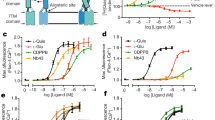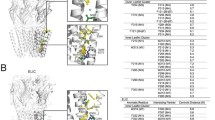Abstract
The glutamate receptor subunits were first thought to cross the cell membrane four times in a manner analogous to the neuronal nicotinic acetylcholine, GABAA, and glycine receptors. This model led the field for nearly five years, although it was frequently in conflict with the data. Recently, comparisons with bacterial proteins, epitope tagging experiments, and the construction of chimeras has produced a new model of glutamate receptor topology that is novel and quite unlike any of the other receptors.
Similar content being viewed by others
References
Barnard E. A., Darlison M. G., and Seeburg P. (1987) Molecular biology of the GABAA receptor: the receptor/channel superfamily.Trends NeuroSci. 10, 502–509.
Bennett J. A. and Dingledine R. (1995) Topology profile for a glutamate receptor: three transmembrane domains and a channel-lining reentrant membrane loop.Neuron 14, 373–384.
Brake A. J., Wagenbach M. J., and Julius D. (1994) New structural motif for ligand-gated ion channels defined by an ionotropic ATP receptor.Nature 371, 519–523.
Burnashev N., Schoepfer R., Monyer H., Ruppersberg J. P., Günther W., Seeburg P., and Sakmann B. (1992) Control by asparagine residues of calcium permeability and magnesium blockade in the NMDA receptor.Science 257, 1415–1418.
Dingledine R., Hume R., and Heinemann S. (1992) Structural determinants of barium permeation and rectification in non-NMDA glutamate receptor channels.J. Neurosci. 12, 4080–4087.
Hollmann M. and Heinemann S. (1994) Cloned glutamate receptors.Annu. Rev. Neurosci. 17, 31–108.
Hollmann M., Maron C., and Heinemann S. (1994) N-glycosylation site tagging suggests a three transmembrane domain toplogy for the glutamate receptor GluR1.Neuron 13, 1331–1343.
Hollmann M., O’Shea-Greenfield A., Rogers S. W., and Heinemann S. (1989) Cloning by functional expression of a member of the glutamate receptor family.Nature 342, 643–648.
Hollmann M., Rogers S. W., O’Shea-Greenfield A., Deneris E. S., Hughes T. E., Gasic G. P., and Heinemann S. (1990) Glutamate receptor GluR-K1: structure, function, and expression in the brain, inThe Brain, vol. LV, Cold Spring Harbor Laboratory, Cold Spring Harbor, NY, pp. 41–56.
Hume R. I., Dingledine R., and Heinemann S. F. (1991) Identification of a site in glutamate receptor subunits that controls calcium permeability.Science 253, 1028–1031.
Köhler M., Burnashev N., Sakmann B., and Seeburg P. (1993) Determinants of Ca2+ permeability in both TM1 and TM2 of high affinity kainate receptor channels: diversity by RNA editing.Neuron 10, 491–500.
Kuryatov A., Laube B., Betz H., and Kuhse J. (1994) Mutational analysis of the glycine-binding site of the NMDA receptor: structure similarity with bacterial amino acid-binding proteins.Neuron 12, 1291–1300.
Martin L. J., Blackstone C. D., Levey A. I., Huganir R. L., and Price D. L. (1993) AMPA glutamate receptor subunits are differentially distributed in rat brain.Neuroscience 53, 327–358.
McGlade-McCulloh E., Yamamoto H., Tan S.-E., Brickey D. A., and Soderling T. R. (1993) Phosphorylation and regulation of glutamate receptors by calcium/calmodulin-dependent protein kinase II.Nature 362, 640–642.
Molnar E., Baude A., Richmond S. A., Patel P. B., Somogyi P., and McIlhinney R. A. (1993) Biochemical and immunocytochemical characterization of antipeptide antibodies to a cloned GluR1 glutamate receptor subunit: cellular and subcellular distribution in the rat forebrain.Neuroscience 53, 307–326.
Mori H., Masaki H., Yamakura T., and Mishina M. (1992) Identification by mutagenesis of a Mg2+-block site of the NMDA receptor channel.Nature 358, 673–675.
Moss S. J., Blacksone C. D., and Huganir R. L. (1993) Phosphorylation of recombinant non-NMDA glutamate receptors on serine and tyrosine residues.Neurochem. Res. 18, 105–110.
Nakanishi N., Schneider N. A., and Axel R. (1990) A family of glutamate receptor genes: evidence for the formation of heteromultimeric receptors with distinct channel properties.Neuron 5, 569–581.
Nakanishi S. (1992) Molecular diversity of glutamate receptors and implications for brain function.Science 258, 597–603.
O’Hara P. J., Sheppard P. O., Thogersen H., Venezia D., Haldeman B. A., McGrane V., Houamed K. M., Thomsen C., Gilbert T. L., and Mulvihill E. R. (1993) The ligand-binding domain in metabotropic glutamate receptors is related to bacterial periplasmic binding proteins.Neuron 11, 41–52.
Petralia R. S. and Wenthold R. J. (1992) Light and electron immunocytochemical localization of AMPA-selective glutamate receptors in the rat brain.J. Comp. Neurol. 318, 329–354.
Raymond L. A., Blackstone C. D., and Huganir R. L. (1993) Phosphorylation and modulation of recombinant GluR6 glutamate receptors by cAMP-dependent protein kinase.Nature 361, 637–641.
Roche K. W., Raymond L. A., Blackstone C., and Huganir R. L. (1994) Transmembrane topology of the glutamate receptor sub-unit GluR6.J. Biol. Chem. 269, 11,679–11,682.
Russell (1982)Form and Function, The University of Chicago Press, Chicago.
Seeburg P. (1993) The molecular biology of mammalian glutamate receptor channels.Trends NeuroSci. 16, 359–365.
Sommer B., Keinanen K., Verdoorn T. A., Wisden W., Burnashev N., Herb A., Kohler M., Takagi T., Sakman B., and Seeburg P. H. (1990) Flip and flop: a cell specific functional switch in glutamate-operated channels of the CNS.Science 249, 1580–1585.
Stern-Bach Y., Bettler B., Hartley M., Sheppard P. O., O’Hara P. J., and Heinemann S. (1994) Agonist selectivity of glutamate receptors is specified by two domains structurally related to bacterial amino acid-binding proteins.Neuron 13, 1345–1357.
Sullivan J. M., Traynelis S. F., Chen H.-S. V., Escobar W., Heinemann S. F., and Lipton S. A. (1994) Identification of two cysteine residues that are required for redox modulation of the NMDA subtype of glutamate receptor.Neuron 13, 929–936.
Taverna F. A., Wang L., MacDonald J. F., and Hampson S. R. (1994) A transmembrane model for an ionotropic glutamate receptor predicted on the basis of the location of asparagine-linked oligosaccharides.J. Biol. Chem. 269, 14,159–14,164.
Tingley W. H., Roche K. W., Thompson A. K., and Huganir R. L. (1993) Regulation of NMDA receptor phosphorylation by alternative splicing in the C-terminal domain.Nature 364, 70–73.
Uchino S., Sakimura K., Nagahari K., and Mishina M. (1992) Mutations in a putative agonist binding region of the AMPA-selective glutamate receptor channel.FEBS Lett. 308, 253–257.
Valera S., Hussy N., Evans R. J., Adami N., North R. A., Surprenant A., and Buell G. (1994) A new class of ligand-gated ion channel defined by P2x receptor for extracellular ATP.Nature 371, 516–519.
Verdoorn T. A., Burnashev N., Monyer H., Seeburg P. H., and Sakmann B. (1991) Structural determinants of ion flow through recombinant glutamate receptor channels.Science 252, 1715–1718.
Wang L.-Y., Taverna F. A., Huang X.-P., MacDonald J. F., and Hampson D. R. (1993) Phosphorylation and modulation of a kainate receptor (GluR6) by cAMP-dependent protein kinase.Science 259, 1173–1175.
Wo Z. G. and Oswald R. E. (1994) Transmembrane topology of two kainate receptor subunits revealed by N-glycosylation.Proc. Natl. Acad. Sci. USA 91, 7145–7158.
Yellen G., Jurman M. E., Abramson T., and MacKinnon R. (1991) Mutations affecting internal TEA blockade identify the probable pore-forming region of a K+ channel.Science 251, 939–942.
Author information
Authors and Affiliations
Rights and permissions
About this article
Cite this article
Hughes, T.E. Transmembrane topology of the glutamate receptors. J Mol Neurosci 5, 211–217 (1994). https://doi.org/10.1007/BF02736722
Received:
Revised:
Accepted:
Issue Date:
DOI: https://doi.org/10.1007/BF02736722




